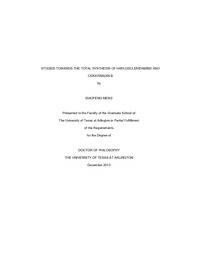
ATTENTION: The works hosted here are being migrated to a new repository that will consolidate resources, improve discoverability, and better show UTA's research impact on the global community. We will update authors as the migration progresses. Please see MavMatrix for more information.
Show simple item record
| dc.contributor.author | Meng, Xiaofeng | |
| dc.date.accessioned | 2017-05-31T19:22:31Z | |
| dc.date.available | 2017-05-31T19:22:31Z | |
| dc.date.submitted | January 2013 | |
| dc.identifier.other | DISS-12530 | |
| dc.identifier.uri | http://hdl.handle.net/10106/26664 | |
| dc.description.abstract | In Chapter 1, we discuss the synthesis of haploscleridamine. Haploscleridamine is a novel tryptamine-derived alkaloid isolated from a sponge of the order Haplosclerida. This alkaloid inhibits cathepsin K, a cysteine protease, which is involved in the catabolism of elastin, collagen, and gelatin allowing the breakdown of bone and cartilage. Cathepsin K "blockers" show great potential in the treatment of osteoporosis. Building off earlier studies, we adopted a novel application of the Buchwald indole synthesis instead of a traditional Fischer indole synthesis to construct the â-carboline fragment. Starting from L-histidine, after several steps including a ring closing metathesis, a cyclohexanone was formed, which is the key precursor for indole formation. In chapter 2, we introduce a novel indole synthesis: a modified Buchwald indole synthesis, which provided mono tosyl protected haploscleridamine. Following deprotection of tosyl group, the natural product haploscleridamine was formed. Because of separation problem, the overall yield was not determined.Ceratinadin B, a quinolone-imidazole-containing alkaloid, was isolated from the marine sponge of a species of Oceanopia. This alkaloid was first discovered in 2001 by researchers at the NIH as a possible inhibitor of a key enzyme in the detoxification cycle of Mycobacterium tuberculosis and other Mycobacterium.In Chapter 3, we briefly introduce tuberculosis, which is currently the second highest cause of death worldwide. New strategies for treating the disease, such as those offered by the alkaloid described above are of special interest because they attack unique enzymatic pathways of the bacterium species that is not found in the human host. Chapter 4 of this dissertation describes a synthetic route to this marine alkaloid which is predicated on the assembly and union of two key fragments: a spiroisoxazoline and an imidazole-quinolone. The spiroisoxazoline fragment was synthesized by using a novel asymmetric palladium-catalyzed dearomatizating spirocyclization instead of chiral auxiliary supported methods reported in the literature. The preparation of the 2-amino-4,5-disubstituted imidazole fragment started from an á-bromoketone and a monoacetylguanidine derivative. A modified Meldrum's acid derivative permitted access to the 3-Cbz protected quinolone derivative utilizing Gould-Jacobs quinoline synthesis. The Cbz, acetyl and phthalimidoyl groups were deprotected by hydrazine in one pot. Excess BBr3 was added to deprotect the two methyl groups attached to benzene ring. Finally, the two fragments, the isoxazoline and the imidazole-quinolone could be coupled to form ceratinadin B. | |
| dc.description.sponsorship | Carl, Lovely | |
| dc.language.iso | en | |
| dc.publisher | Chemistry & Biochemistry | |
| dc.title | Studies Towards The Total Synthesis Of Haploscleridamine And Ceratinadin B | |
| dc.type | Ph.D. | |
| dc.contributor.committeeChair | Carl, Lovely | |
| dc.degree.department | Chemistry & Biochemistry | |
| dc.degree.discipline | Chemistry & Biochemistry | |
| dc.degree.grantor | University of Texas at Arlington | |
| dc.degree.level | doctoral | |
| dc.degree.name | Ph.D. | |
Files in this item
- Name:
- Meng_uta_2502D_12530.pdf
- Size:
- 5.281Mb
- Format:
- PDF
This item appears in the following Collection(s)
Show simple item record


